The 7.62 mm caliber is a nominal caliber used for a number of different cartridges. Historically, this class of cartridge was commonly known as .30 caliber, the equivalent in Imperial and United States Customary measures. It is most commonly used in hunting cartridges. The measurement equals 0.30 inches or three decimal lines, written .3″ and read as three-line.

A cartridge, also known as a round, is a type of pre-assembled firearm ammunition packaging a projectile, a propellant substance and an ignition device (primer) within a metallic, paper, or plastic case that is precisely made to fit within the barrel chamber of a breechloading gun, for convenient transportation and handling during shooting. Although in popular usage the term "bullet" is often used to refer to a complete cartridge, the correct usage only refers to the projectile.

The .38 Special, also commonly known as .38 S&W Special, .38 Smith & Wesson Special, .38 Spl, .38 Spc, or 9x29mmR is a rimmed, centerfire cartridge designed by Smith & Wesson.

The Colt Single Action Army is a single-action revolver handgun. It was designed for the U.S. government service revolver trials of 1872 by Colt's Patent Firearms Manufacturing Company and was adopted as the standard-issued pistol of the U.S. Army from 1873 until 1892.

The .357 Smith & Wesson Magnum, .357 S&W Magnum, .357 Magnum, or 9×33mmR is a smokeless powder cartridge with a 0.357 in (9.07 mm) bullet diameter. It was created by Elmer Keith, Phillip B. Sharpe, and Douglas B. Wesson of firearm manufacturers Smith & Wesson and Winchester. The .357 Magnum cartridge is notable for its highly effective terminal ballistics.

Rimfire ammunition (RF) is a type of firearm metallic cartridge whose primer is located within a hollow circumferential rim protruding from the base of its casing. When fired, the gun's firing pin will strike and crush the rim against the edge of the barrel breech, sparking the primer compound within the rim, and in turn ignite the propellant within the case. Invented in 1845, by Louis-Nicolas Flobert, the first rimfire metallic cartridge was the .22 BB Cap cartridge, which consisted of a percussion cap with a bullet attached to the top. While many other different cartridge priming methods have been tried since the mid-19th century onwards, such as pinfire, only small caliber rimfire and centerfire cartridges have survived to the present day with regular usage. The .22 Long Rifle rimfire cartridge, introduced in 1887, is by far the most common ammunition in the world today in terms of units sold.

A wadcutter is a special-purpose flat-fronted bullet specifically designed for shooting paper targets, usually at close range and at subsonic velocities typically under approximately 270 metres per second (890 ft/s). Wadcutters have also found favor for use in self-defense guns, such as .38 caliber snubnosed revolvers, due to shorter barrel lengths, lower bullet velocities, and improved lethality. Wadcutters are often used in handgun and airgun competitions.

The .22 Long Rifle or simply .22 LR or 22 is a long-established variety of .22 caliber rimfire ammunition originating from the United States. It is used in a wide range of rifles, pistols, revolvers, and submachine guns.

The .45 Colt (11.43×33mmR), is a rimmed, straight-walled, handgun cartridge dating to 1872. It was originally a black-powder revolver round developed for the Colt Single Action Army revolver. This cartridge was adopted by the U.S. Army in 1873 and served as an official US military handgun cartridge for 19 years, before being replaced by the .38 Long Colt in 1892.
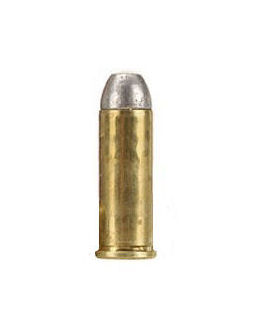
The .38 Long Colt, also known as .38 LC, is a black powder cartridge introduced by Colt's Manufacturing Company in 1875. In 1892, it was adopted as a standard military pistol cartridge by the United States Army for the Colt M1892 revolver. The metric designation for the .38 Long Colt is 9.1×26mm. It is slightly more powerful than the .38 Short Colt, also known as .38 SC. The original .38 SC and .38 LC differ in case length, bullet diameter, weight, and design and are not interchangeable; however, modern production .38 SC ammunition is now loaded with a smaller, internally-lubricated bullet which can be fired from firearms chambered in .38 LC or .38 Special. The modern .38 LC can be fired from .38 Special firearm, but not from a firearm designed for the .38 SC, since the case length is too long.

The .44 Remington Magnum, also known as .44 Magnum or 10.9x33mmR, is a rimmed, large-bore cartridge originally designed for revolvers and quickly adopted for carbines and rifles. Despite the ".44" designation, guns chambered for the .44 Magnum round, its parent case, the .44 Special, and its parent case, the .44 Russian all use 0.429 in (10.9 mm) diameter bullets. The .44 Magnum is based on the .44 Special case but lengthened and loaded to higher pressures for greater velocity and energy.
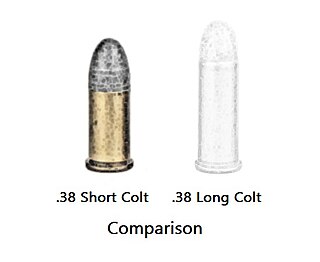
The .38 Short Colt, also known as .38 SC, is a heeled bullet cartridge intended for metallic cartridge conversions of the cap and ball Colt 1851 Navy Revolver from the American Civil War era.
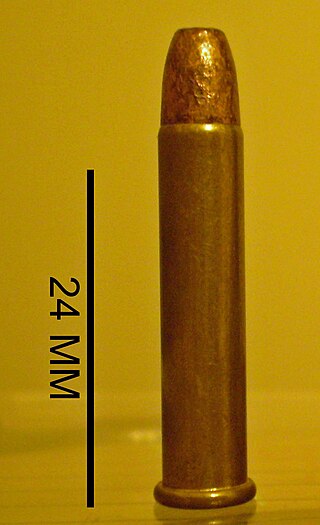
The .22 Winchester Magnum Rimfire, also called .22 WMR, .22 Magnum, .22 WMRF, .22 MRF, or .22 Mag, is a rimfire cartridge. Originally loaded with a bullet weight of 40 grains (2.6 g) delivering velocities in the 2,000 feet per second (610 m/s) range from a rifle barrel, .22 WMR is now loaded with bullet weights ranging from 50 grains (3.2 g) at 1,530 feet per second (470 m/s) to 30 grains (1.9 g) at 2,200 feet per second (670 m/s).

A heeled bullet is a bullet that is necked-down at its base to allow a projectile the full internal diameter of a gun barrel to fit in a cartridge case of the same or narrower dimension. Heeled bullets mostly disappeared with the advent of smokeless powder cartridges, though older rimfire designs, such as the .22 caliber rimfire cartridges, still use heeled bullets, and many cartridges that date back to the black powder era still reflect their heeled bullet origins in their caliber designations.

The Ruger Blackhawk is a six-shot, single-action revolver manufactured by Sturm, Ruger & Co. It is produced in a variety of finishes, calibers, and barrel lengths.

Elmer Merrifield Keith was an American rancher, firearms enthusiast, and author. Keith was instrumental in the development of the first magnum revolver cartridge, the .357 Magnum (1935), as well as the later .44 Magnum (1956) and .41 Magnum (1964) cartridges, credited by Roy G. Jinks as "the father of big bore handgunning." Keith was born in Hardin, Missouri, and overcame serious injuries that he had sustained at age 12 in a fire when he was living in Missoula, Montana.
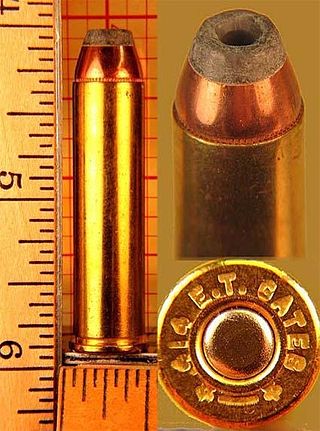
A super magnum is a longer and/or more powerful version of a "magnum" cartridge. Although the term "super magnum" typically refers to a handgun cartridge, created by lengthening an existing straight-case design, it can also refer to rifle and shotgun cartridges, such as the .17 Winchester Super Magnum and the 31⁄2" 12 Gauge Super Magnum. In this case, it simply denotes that it is of greater power than existing "magnums" of a similar caliber or gauge, this is comparable to other designations, such as the "Remington Ultra Magnum". The most widespread of these cartridges are the "SuperMag" family of super-magnum handgun cartridges that were proposed and tested by Elgin Gates in the 1970s.

The .44 Colt is an American centerfire revolver cartridge that was produced commercially from 1871 to 1940.

The .44 Remington Centerfire was a centerfire revolver cartridge with a heeled, externally lubricated bullet produced by the Remington Arms Company from 1875 until 1895. Only one weapon, the Remington Model 1875, was chambered for this cartridge.
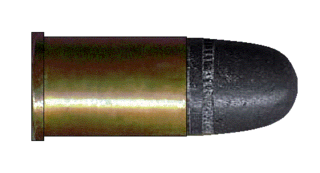
The .41 Short Colt cartridge was created in 1873 for Colt's single-action "New Line" revolver.



















